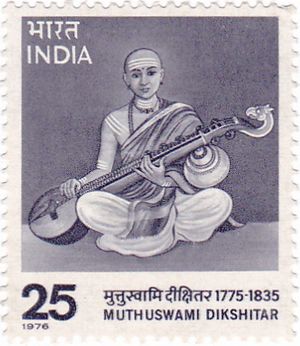Muthuswami Dikshitar facts for kids
Quick facts for kids
Muthuswami Dikshitar (Mudduswamy Dikshitar)
|
|
|---|---|
 |
|
| Born | 24 March 1775 |
| Died | 21 October 1835 (aged 60) Ettayapuram, India
|
| Other names | Guruguha |
| Occupation | Carnatic music composer |
| Parent(s) |
|
Muthuswami Dikshitar (born March 24, 1775 – died October 21, 1835) was a famous poet, singer, and veena player from South India. He is known as one of the greatest composers of Indian classical music. People often call him just Dikshitar.
He is considered one of the "musical trinity" of Carnatic music. This means he was one of the three most important composers of this style. The other two were Tyagaraja and Syama Sastri.
Dikshitar's songs are special because they describe Hindu gods and temples in a very detailed and poetic way. He also used a unique style of playing the veena, which made his music sound very deep and soulful. He signed his songs with the name Guruguha.
Most of his songs are in Sanskrit, an ancient Indian language. This is different from the other two trinity composers, whose songs were mostly in Telugu. He also wrote some songs using a mix of Sanskrit and Tamil.
Contents
Early Life and Learning
Muthuswami Dikshitar was born on March 24, 1775, in Thiruvarur, a town in what is now Tamil Nadu, India. His father, Ramaswami Dikshitar, was also a composer. Ramaswami taught Muthuswami many things, including ancient scriptures called vedas, poetry, music, and astrology. Muthuswami had two younger brothers, Chinnaswami and Balaswami, and a sister named Balamba.
Later, Muthuswami moved to a town called Manali, near Madras (now Chennai). There, he and his brothers learned about Western orchestral music and the violin.
An important teacher named Chidambaranatha Yogi took Muthuswami to the city of Benares (now Varanasi). In Benares, Muthuswami learned a lot about music, philosophy, and yoga. He also heard Hindustani classical music, which is a different style of Indian classical music. Some people believe this style influenced his later compositions. After his teacher passed away, Dikshitar returned to South India and settled in Tiruttani.
Musical Journey
A famous story says that at the temple in Tiruttani, the god Murugan put a piece of sugar candy in Dikshitar's mouth. This moment is said to have started his amazing music career. It's also when he chose his special signature name, Guruguha, which is another name for Murugan. His very first song was Śrināthādi guruguho jayati jayati.
Dikshitar then went on a journey, visiting many temples. He composed beautiful songs at places like Kanchipuram, Tiruvannamalai, Chidambaram, Tirupati, Kalahasthi, and Srirangam. After his travels, he returned to his hometown of Thiruvarur.
Dikshitar became a master of the veena, a string instrument. The way he played the veena greatly influenced his compositions. He even called himself a "player of the veena" in one of his songs. He also experimented with the violin. His disciples, especially Vadivelu and his brother Balaswami Dikshitar, were among the first to use the violin in Carnatic music. Today, the violin is a very important part of most Carnatic music groups.
Back in Tiruvarur, he wrote songs for almost every god and goddess in the huge temple complex. This included the famous Kamalamba Navavarna Kritis, which are a set of nine songs praising the goddess Kamalambal. He also composed the Navagraha Kritis, which are songs praising the nine planets. These songs show his deep knowledge of ancient texts and beliefs.
Later Life and Legacy
Muthuswami Dikshitar passed away on October 21, 1835, in Ettayapuram. He did not have any children. A special memorial, called a samadhi, was built in his honor in Ettayapuram. Many musicians and fans visit it today.
His brothers, Chinnaswami and Balaswami Dikshitar, were also talented musicians. Balaswami was especially important for bringing the Western violin into Carnatic music. Balaswami's grandson, Subbarama Dikshitar, was also a composer and scholar. He wrote down 229 of Muthuswami Dikshitar's songs in his book, Sangeeta Sampradaya Pradarshini.
Many of Dikshitar's students became famous musicians themselves. They helped carry on his unique musical style and teachings.
Because of his amazing creativity and the spiritual depth of his songs, Dikshitar is remembered as one of the "Trinity of Carnatic music." He stands alongside his friends and fellow composers, Tyagaraja and Shyama Shastri.
His Music and Compositions
Muthuswami Dikshitar composed about 450 to 500 songs. Many of these are still widely performed in Carnatic music concerts today. Most of his compositions are in Sanskrit and are in a style called Krithi, which means poetry set to music. He traveled to many holy places and wrote songs about the gods and temples he visited. He wrote about more different gods than almost any other composer.
Each of his songs is special and carefully made. They are known for their deep and soulful melodies. His Sanskrit lyrics praise the temple gods, but they also include ideas from Advaita Vedanta, a type of Hindu philosophy. His songs also share interesting facts about the history of the temples and their customs. He was also very skilled at making the lines in his songs rhyme beautifully.
Dikshitar also tried to compose songs in all 72 of the main Melakartha ragas (musical scales). This helped to preserve many rare and forgotten ragas. He was also a master of tala, which means rhythm. He is the only composer to have songs in all seven basic rhythmic patterns of Carnatic music.
His songs are praised for their rich musical feeling, their deep philosophical meaning, and their grand lyrics. One of his most famous songs is Vatapi Ganapatim.
Dikshitar was also exposed to Western music when he was young. He even composed about forty songs using Western folk tunes, adapting them to Indian ragas. These songs are known as nottusvara sahitya. You can hear influences of Celtic and Baroque styles in these pieces.
See also
 In Spanish: Muthuswami Dikshitar para niños
In Spanish: Muthuswami Dikshitar para niños

